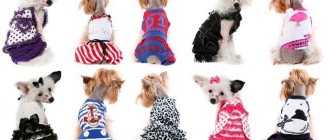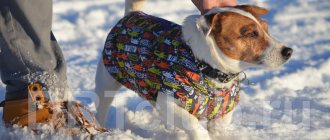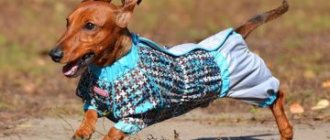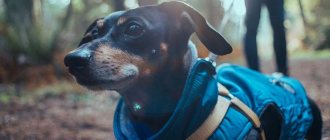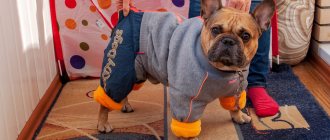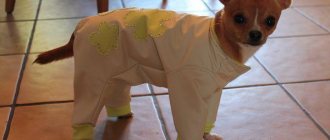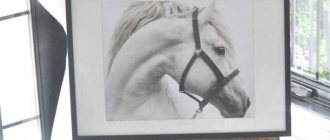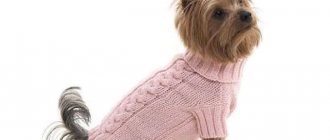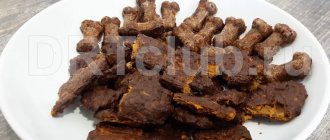Who would have thought that patterns and workshops for dog clothing would become so popular! However, this is true. Here are a few more options for you. Even just repurposing old clothes.
Those owners who dress their dogs for a walk know that there should be several things. This is especially true in autumn and winter.
During walks, dogs run, jump, and sometimes fight. They do not take care of their clothes, which get wet, dirty and torn. In the rainy season, you have to wear a new thing for every walk, because the old one is still drying after washing.
The stores are now full of different things for animals, but they are still too expensive. There is only one way out - sew or knit things for dogs with your own hands. When we sew or knit ourselves, we can use leftover yarn, scraps of fabric, old clothes and knitted sweaters and hats.
I don’t dress my dogs, but I had to think about outfitting my friend’s pet. Her dog is quite large, a Doberman, but she gets cold both in the fall and in the winter.
Unfortunately, not everyone is friendly with needlework, and everyone wants to dress their pet cheaply. I want to offer for your consideration the simplest DIY knitted items for dogs. Some of them can be done even by those who do not know how to knit at all. I hope that everyone can hold a needle and thread in their hands and at least somehow wield them.
Red blouse from an old hat.
This blouse is suitable for small dogs whose back length is equal to the length of an old hat. In order to make such clothes, you need to take an unnecessary hat and rip it open at the top. You will end up with something like a pipe.
Those who know how to knit at least a little can tie an elastic band around the neckline. Those who don’t know how to knit can either sew a neckline from an old sweater to the neckline, or simply fold it along the edge and sew it on, and pass braid, ribbon, or cord inside to then tighten the neckline.
When the neckline is finished, you need to try the jacket on the dog and mark the places where the front legs begin. Remove the pet's jacket and make slits in the designated places. The slots must be processed either with a crochet hook or with a thread and a needle. Do not tighten the edges of the slots.
For larger dogs, instead of a hat, take an old sweater or jacket and the dog clothes are made either from their sleeves (you will get two things at once), or from the front and back, but without sleeves (the armhole cutout will serve as a cutout for the front paws). If you take something with a fastener, you can simply and easily put the jacket on your dog, and then fasten it.
For those who know how to knit at least a little, I present the following model.
Preparation of materials
In order to transform a sweater for a person into a sweater for a small, weak dog, we only need:
- the sweater itself;
- sharp scissors;
- black marker.
However, there is one “but”. To create clothes for a dog, only a sweater whose sleeve volume corresponds to the animal’s carcass is suitable. That is, to put it simply, the dog should fit comfortably in the sleeve of the jacket. If the sleeve in a sweater is smaller, then a suitable blouse can be bought at a second-hand store.
Dog blanket
To make such a blanket, leftover yarn of different colors is suitable. The more leftovers there are, the brighter and more elegant the DIY dog items will be.
Start knitting from the neckline and knit a strip with a length equal to half the circumference of the neck. Slip the knitting onto a spare needle, leaving the stitches closed.
Then knit exactly the same strip and attach loops from an additional knitting needle to it. Between the loops of the strips, you need to pick up additional loops so that the product does not meet at an angle on the neck. How many additional loops you need to cast on will depend on the thickness of the yarn and the volume of the animal’s neck.
We connected two strips, and then we knit right to the very beginning of the tail. We close all the loops.
Now we knit a belt. It passes under the front legs and its length is equal to the volume of the chest minus the width of the blanket. The belt can be tied directly into the blanket, or it can be tied separately and then sewn on. If desired, you can sew only one side of the belt, and fasten the other with a button or Velcro.
We make the neck fastener. The neck can be fastened with buttons, Velcro or snaps, whichever is more convenient for you.
The blanket is ready.
For those who know how to knit, I suggest creating a beautiful jumper.
Making a Sweater
Next, we make a collar in a blouse for a dog, turning the sleeve fabric outward in the place where the cuffs were cut off, a couple of centimeters. By the way, ideally, before doing this, you can sweep the area with a thread matched to the color of the dog’s sweater so that it does not fray.
And those places where the cuts for the paws are made need to be slightly expanded by cutting out a little fabric from there or slightly stretching the resulting hole with your fingers.
After this, if necessary, you need to cut off a small amount of fabric on the other side of the sleeve if the resulting sweater is too large, and the clothes for your pet will be ready.
All that remains is to dress the animal in a sweater and give him the opportunity to enjoy his new outfit.
Found a violation? Report content
Gray jumper with red stripes
We start knitting with the elastic band of the neck. The elastic band should be double (folded twice) for density. Place the seam on the side of the product, this will make it easier to knit.
When the neck is knitted, divide the loops in half. We knit the front and back separately.
As soon as the length of the parts is equal to half the volume of the front legs, we connect the front with the back and knit further with one fabric. The seam will be on the side. We continue knitting.
For boys: we close the loops on the stomach as soon as the fabric reaches an important place, and we continue to knit the fabric on the back until the beginning of the tail.
For girls: we knit the fabric to the base of the tail.
We close the loops.
We collect loops on the slots for the paws and knit with an elastic band with a turn-up. We close the loops.
The jumper is ready. For security, you can pass a braid or cord around the neckline and then tighten it around your neck.
Overalls for Yorkshire Terrier
© Depositphotos
The clothing pattern for small terriers consists of four parts: back, front, collar and sleeves. By the way, now Yorkies are one of the most popular dogs among city residents due to their sociability, intelligence, small size and beautiful appearance.
- Cut out two identical backs and one front from the selected fabric, leaving seam allowances.
- Pin and stitch the parts along lines AB and VG.
- Connect the back parts along line DE.
- Sew on the front, collar and sleeves.
- Lice the zipper along the IR line or make several ties.
Knitted pants for dogs
If desired, you can also knit pants. To do this, you need to make cuts for the hind legs. They are performed in exactly the same way as for the front ones. An elastic cuff is attached to the cuts.
The last two photos are for those who know how to sew. We sew according to the pattern, there should be no problems here.
Hoodie pattern
The dog hoodie pattern is very similar to the jacket pattern I made for Jack. By the way, you can find a detailed master class on sewing such a jacket in the article: DIY dog jacket.
Basic measurements for creating a pattern
To create the pattern, I took the following measurements from Jack.
Hoodie pattern for a dog
Of course, there are differences in sewing a jacket and a hoodie for a dog. But I propose the principle of constructing a pattern “on a grid” in both versions. Moreover, in my opinion, this method is the simplest.
You can learn how to build a mesh and then transfer a pattern onto it from this video.
Well, I never tire of repeating it. Any pattern from the Internet is not universal. You may have to “adjust” it a little to suit your little one. Therefore, after you have created a pattern, transfer it to some plain fabric. This way you will understand exactly what needs to be adjusted.
I ended up with this hoodie pattern for a dog.
Coat for a dog according to the pattern
I hope that I have helped a little for those who want to make things for their dogs with their own hands.
https://mydog.su/forum/veshchi-dlya-sobak-svoimi-rukami
Share link:
Liked this:
Like
Blanket for dachshund
To sew a simple blanket for your dachshund, you will need to measure only two parameters: Ds (back length) and Og (chest volume). The blanket is convenient because it does not prevent male dogs from urinating and protects the chest from pneumonia. If you have a girl, then the bottom panel can be made the same length as the top one.
© Depositphotos
To protect your pet from rain and wet snow, you can make double panels: the top is made of thin raincoat fabric, and the inside is made of wool.
As a basis for the collar, you can use an ordinary grosgrain ribbon, sew it in half and pass it through the drawstrings of the upper and lower panels, connect the ends of the ribbon and sweep it away. Unlike overalls, a dachshund blanket does not restrict movement, allowing your pet to enjoy active games while walking.
Winter clothes
For many short-haired breeds (Dalmatians, Beagles, etc.), winter overalls are a necessity, especially for long walks. A thick waterproof top, thin filling and fleece or flannel as a lining are quite suitable for active dogs. In such a jumpsuit your pet won't be cold, but it won't get too hot after playing or jogging either.
For long walks, trips to nature, to the country - when the animal will be outdoors for several hours in a row, choose warmer clothes. And for small and medium-sized breeds (Chihuahua, Dachshund, Yorkshire Terrier, Spitz, French Bulldog, Lapdog, Spaniel, etc.), give preference to fur-lined overalls. Modern fillings such as synthetic winterizer or synthetic fluff are also suitable. Very light, but at the same time warm, they will not cause discomfort to the dog, allowing it to move.
Dogs of the Chinese Crested, Mexican or Peruvian Hairless breed will need to wear a sweater underneath.
Taking measurements from the dog
Before you sew clothes for your pet, you need to take his measurements. These are the basic parameters of the body, which are then applied to the fabric. Moreover, the recommendations are valid for all breeds, from a small toy terrier to a large great dane.
During measurement, you need to study 2 rules in detail:
- The measuring tape should be pressed tightly against the body. Not just touching the fur, but tightening the skin, but without pressing.
- You need to add a few centimeters to the results obtained so that the dog can turn around calmly. This is especially true for breeds that cannot sit still.
After this, you just need to transfer the resulting replacements to the drawing and translate it into fabric.
So how do you take measurements from a dog? Need to measure:
- Back length, from neck to tail root;
- Volume of the sternum and cervical region;
- The volume of the waist belt together with the distance from the neck to the beginning of the hind legs;
- Girth of forelimbs;
- The length of the sleeve with the girth of the forelimb;
- Length of trousers;
- Length from genitals;
- The gap between the forelimbs and the gap between them and the hind limbs;
- Interaural distance;
- The volume of the head below, above, in front of the ears.
The tail is taken into account very rarely, for example, when sewing a designer jumpsuit. The only thing is that a hole or a small sleeve is cut out for the tail.
Dog clothes are usually sewn not only based on parameters. If the dog is a hunting breed, they need to move a lot, so things should always be looser for them.
We sew a complete wardrobe for York with our own hands
It’s amazing to me how housewives simply love to sew clothes for Yorkies. Maybe this is a model breed. Anyway, today we’re talking about a complete wardrobe for a beautiful Yorkie – boys and girls.
Nowadays, you can often see stylish girls with miniature dogs sitting in their arms, also dressed in fashionable suits. The article is devoted to what kind of clothes there are for Yorkies, and how you can sew or knit an interesting suit for your pet with your own hands.
How to make your own bag on your dog’s back for hiking?
A hiking backpack for a dog (see photo) consists of two bags connected by a fabric piece on the back and equipped with straps that go under the animal’s belly and chest. First, 2 handbags are sewn, the length of which corresponds to the distance from the withers to the lower back (or less, if desired). In height, they can reach the stomach or be slightly shorter. A piece of fabric is sewn between them, which will run across the back, equal to its width. Straps are attached to the bottom and side of the backpack to secure the product.
Source
Fashion ideas for different occasions
A dachshund’s personal wardrobe is needed not only to protect the animal from bad weather and cold. With the help of clothing, the owner shows the personality and charm of his pet.
Exhibition options
At the exhibition it is especially important to demonstrate your pet in all its glory. And a beautiful outfit may well serve this purpose.
Dog owners can decorate their pets with unusual clothes, bought in a store or made with their own hands.
A fashionable wardrobe for a dog may include:
- overalls;
- blankets;
- sweaters;
- coat;
- jackets;
- vests;
- trousers;
- tunics;
- caps and hats;
- smart shoes.
For winter
For cold, snowy winters, overalls with high-quality insulation or a fur coat are perfect for dachshunds to wear.
Your dog should have several warm clothes in his wardrobe so that it is important to wash them.
We knit ourselves
You don’t have to buy all these things in stores - you can knit clothes for dogs with your own hands. This will require very few items and a little patience and skill.
What you need
What do you need to knit a sweater for a dog? Not as much as it might seem. Tools:
- knitting needles or crochet hook;
- scissors;
- rubber;
- threads;
- centimeter, pen and piece of paper for taking measurements;
- needle.
This is probably all that is needed in addition to the yarn already purchased. But knitting threads are a separate matter. The choice of yarn will be entirely up to you and depend on the purpose for which the sweater is knitted. The main qualities that threads must have are:
- naturalness;
- the ability to ensure good thermoregulation (in cold weather - warm, in warm weather - do not overheat the pet);
- convenience.
Therefore, avoid purchasing synthetic yarn that is scratchy. For a summer version of a blouse, you can buy cotton threads. For the winter, you can knit a sweater made of mohair, wool and acrylic for your pet.
Avoid cheap, low-quality yarn, especially those made in China. It may contain harmful substances that can cause allergies.
Instructions - how to knit a sweater
How to knit a sweater for a dog? The following instructions will help beginners.
- Work should begin by taking measurements. For dogs of the same breed, standard measurements may be suitable, which can be found in the master classes provided on the Internet. But still, in order for the product to fit well, it is best to make the measurements yourself. You need to know the following parameters: leg girth, back and tummy length, chest girth.
- The first step is to determine the knitting density for each specific yarn. To do this, knit a small sample of the selected pattern with knitting needles and count how many loops fit into 1 cm.
- Now count the number of loops based on the dog’s measurements. For example, by multiplying the number of loops per 1 cm circumference of the chest, we find out how many of them there will be in this part of the sweater.
- When knitting a sweater for a dog, you always start with the collar. In this part of the garment, the number of loops should be less than in the chest circumference. Therefore, from the number of loops in the girth, subtract 20 pieces (for small dogs) and 30 for larger ones. Cast on the resulting number of stitches onto the needles.
- Let's start knitting the neckline. Divide the total number of stitches cast on by 5. Knit the first and last part with an elastic band 1*1, and knit the rest with stockinette stitch.
- Where you knitted with satin stitch, you will begin to create rows for the back, and where with an elastic band - for the tummy. In every second row, add loops to expand. At the same time, those that are added from the elastic side are included in its pattern, and those that are knitted are knitted in satin stitch. In this way we knit 10 rows (you get 5 increments of 4 loops each) for the Yorkshire Terrier, for the Jack Russell - 16 rows.
- Don't forget about the holes for the legs - they need to be made approximately 5-7 cm from the starting row. They are easy to knit: on the front row, knit 3-5 elastic loops, close them, then knit 3-5 stitches with satin stitch. Now knit all the satin stitches except the last 3-5 and bind them off. Close the elastic loops, knit the last 3-5 loops according to the pattern.
- Then, on the purl row, cast on air stitches in an amount equal to the closed loops in the previous row. In the next front row, knit the cast-on loops with an elastic band.
- Now knit the sweater to the very end of the tummy. Don’t forget to gradually make decreases so that the blouse narrows and the belly of the finished product does not hang. To do this, in every 8 row, 2 loops (adjacent satin stitch and elastic) are knitted together. Where the tummy ends, transfer the elastic loops to separate knitting needles and now knit only the back stitch.
- We knit the bottom of the blouse with an elastic band - about 6-8 rows.
- The sweater knitted by hand is almost ready, now all that remains is to sew its details along the edge loops.

